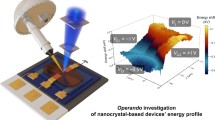60
with trains of picosecond infrared (IR) pulses, tuned over the 8–15 μm range, is studied. At some specific wavelengths, white-light emission as well as ejection of ionic species from the solid is observed. The spectral characteristics of the white-light emission resemble those of a black body. The mass distribution of the ejected ionic species shows substantial amounts of C60 coalescence products. Unexpectedly, all these processes only occur at wavelengths where solid C60 is relatively transparent. No white-light emission nor ejection of ionic species is observed when being resonant with an IR-allowed transition of C60. It is concluded that regular C60 is not the chromophore for the observed processes, and that sequential absorption of single photons by a strong absorber that is dilute in the crystal takes place. Plausible chromophores are sites that are intercalated with alkali metals. Accumulation of energy at these sites leads to fullerene coalescence in the solid, ion ejection, and white-light emission, ultimately resulting in the destruction of the C60 molecules.
Similar content being viewed by others
Author information
Authors and Affiliations
Additional information
Received: 14 April 1998/Accepted: 22 April 1998
Rights and permissions
About this article
Cite this article
von Helden, G., Holleman, I., Putter, M. et al. Photochemistry of solid C60 with tunable infrared radiation . Appl Phys A 67, 161–167 (1998). https://doi.org/10.1007/s003390050755
Issue Date:
DOI: https://doi.org/10.1007/s003390050755




